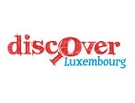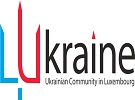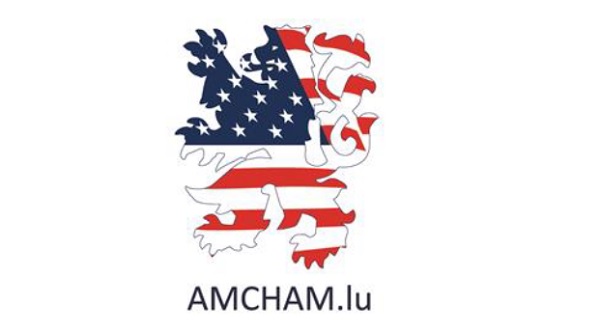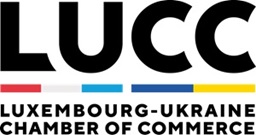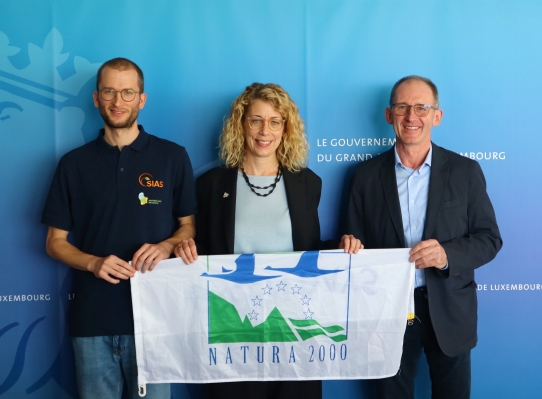 (L-R) Tobias Mosthaf, animator Natura2000 pilotage committee "Guttland Mosel"; Joëlle Welfring, Minister of Environment, Climate and Sustainable Development; Amand Kaiser, Biobauer Toodlermillen;
Credit: MECDD
(L-R) Tobias Mosthaf, animator Natura2000 pilotage committee "Guttland Mosel"; Joëlle Welfring, Minister of Environment, Climate and Sustainable Development; Amand Kaiser, Biobauer Toodlermillen;
Credit: MECDD
On Wednesday 26 October 2022, Luxembourg's Minister for the Environment, Climate and Sustainable Development, Joëlle Welfring, launched the new communication campaign around Natura 2000 sites in Luxembourg.
Natura 2000 is a community network of nature protection areas created under the 1992 Habitats Directive. In addition to "Habitat Zones" or "Special Conservation Areas" (SACs), the network also includes areas designated in under the Birds Directive of 1979 (updated in 2009) and Special Protection Areas (SPAs). The purpose of the network is the preservation and protection of the most threatened emblematic species and habitats in Europe.
The objective is to promote Natura 2000 sites through information and awareness. At the centre of communications is the commitment of the steering committees and their leaders, whose mission is to implement protection and renaturation measures, and let residents discover the benefits and effects of environmental protection zones as well as the different species, their daily lives and their well-being.
The situation in Luxembourg
According to the ministry, Luxembourg is facing a climate crisis and a biodiversity crisis and it is therefore urgent to act. According to the report of the National Observatory for the Protection of the Natural Environment, two thirds of natural habitats and 80% of species have a poor conservation status. Ecosystems must be restored in order to ensure their natural functions. The ability to store carbondioxide and water or to filter air and water are invaluable ecosystem services for climate protection.
The European biodiversity strategy aims, among other things, to protect 30% of the land surface in Europe. More than 27% of the surface of Luxembourg is currently protected under the status of Natura 2000 area. The protection and restoration in these areas is done by adopting a proactive and contractual approach. In order to involve the greatest number of residents in the protection of nature and to communicate its incalculable value, awareness is a very important tool.
The steering committees (COPILS) are made up of local actors who know the regions' territories perfectly and are coordinated by their respective leaders. Their main objective is to create a regional platform that allows better involvement of the various local, municipal and regional actors in order to promote the maintenance of biodiversity while taking into account ecological, economic, social, cultural and regional requirements. Management plans define concrete conservation and restoration objectives for each Natura 2000 area. In collaboration with the Nature and Forest Agency (ANF) and the administration of water management (AGE), the facilitators oversee the implementation of these management plans.
The communication campaign
During the year 2023, eight videos will be gradually published. They will be broadcast on social networks and on the new website www.natura2000.lu. The first video explains in an animated way the Natura 2000 network and its objectives. Each COPIL is presented by its host in a video. The specificities of these territories as well as concrete projects are highlighted. The first video represents the COPIL “Uewersauer” with its host Patrick Thommes.
The new website is dedicated to Natura 2000 areas, their species and habitats and to COPILS. This site will be regularly updated with new articles on the latest projects or protected habitats and species. Articles will focus on one species or habitat and will show how a variety of species benefit from the protection of an umbrella species in its specific habitat, as is the case for example with Emerald at thin body. Other projects will highlight the maintenance of the landscape through agricultural use, such as grazing in former mining sites.
Tobias Mosthaff, animator of the COPIL Guttland Musel, presented the maintenance of high-stem orchards, in Luxembourgish “Bongerten” in his region. The revaluation of this specific habitat is on the one hand beneficial to several endangered species, such as the little owl on the other hand to the promotion of local production. Organic farmer Amand Kaiser presented his company which combines farming according to the criteria of biodynamic agriculture and ecological tourism.



